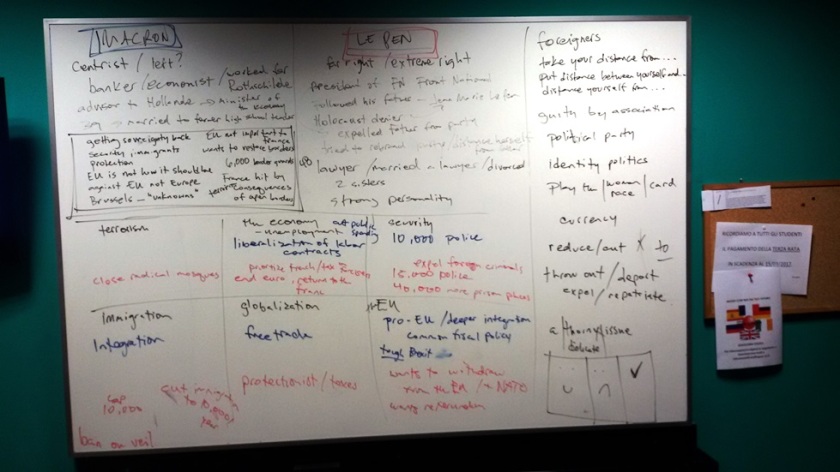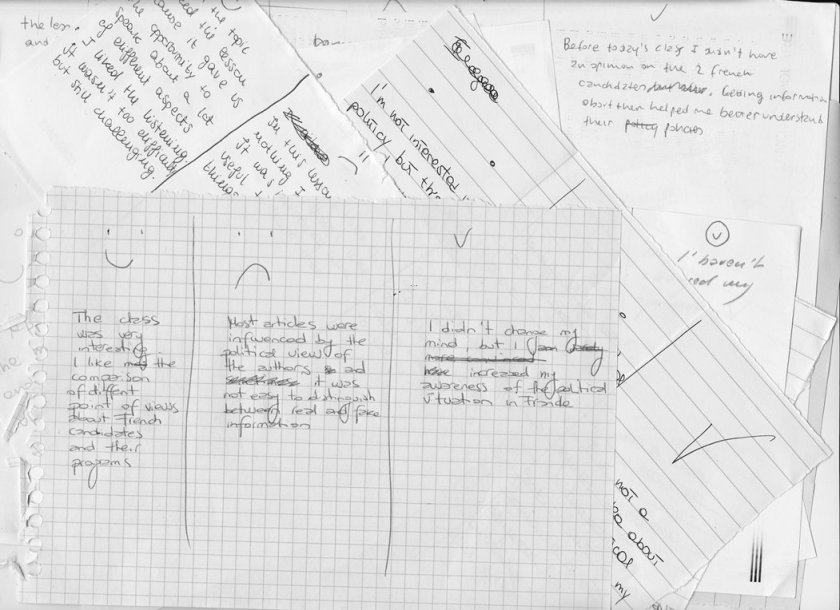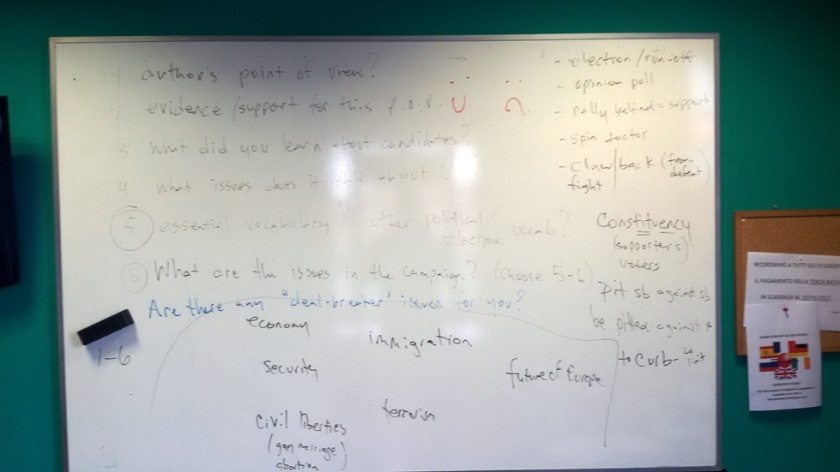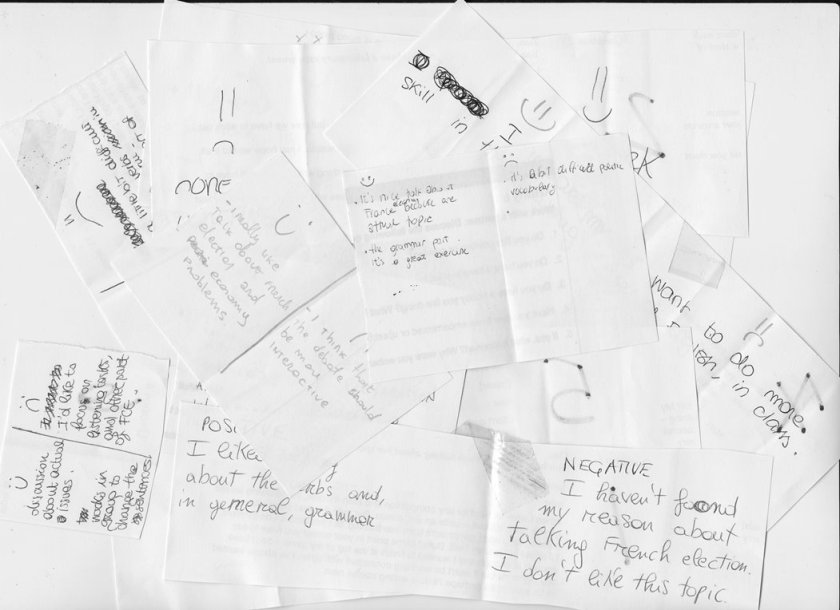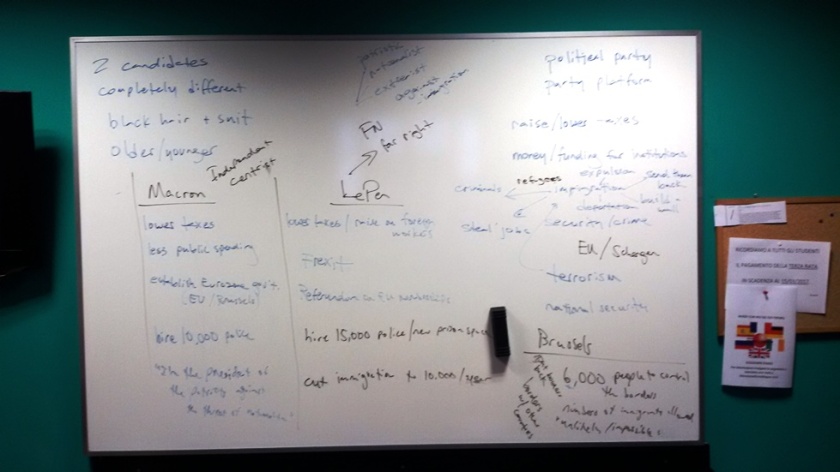I teach, and have always taught, mostly adult-student-customers in private language schools. If you’re like me, you teach grammar and lexis, help students developing writing and listening skills, and focus on communication of meaning. Meaning, but not content. Not ideas. Or beliefs. Or values. Or knowledge or ignorance. Because, like me, you’re just an English teacher.
But my wise Delta tutor once made a useful distinction being just a teacher and being an educator, reminding us that we shouldn’t forget about being the latter. What she meant, I think, is obvious to anyone who sticks their head out of ELT for a moment, and pushes aside, if just for a moment, all the talk about exam performance and teacher accountability, and thinks back to the idea of a school teacher that predated our corporate model of an efficient, corporate school measuring its success in spreadsheet-ready KPIs.
Educators are more than just teachers. They’re part of a community, and perform a public service, helping their students think about and grow in ethical, moral and intellectual dimensions.
It’s the sort of description that normally makes me blush, because it feels so embarassingly far from any conception I’ve ever had of myself as a teacher. But last week, with those same adult-student-customers I’ve always taught, I got a glimpse of what it’s like to be both a teacher and an educator, helping facilitate a real eduucational experience and a community service.
Because we spent two class periods investigating and discussing the Refugee crisis here in Italy.
But just to be clear, I’m not the hero of this story. Her name’s Valentina. My only claim is that I got up the courage to do something that seemed daunting to me at first and went beyond my remit as “just a language teacher”.
First I’ll outline what we did over the two, 2-hour sessions, then I’ll relate some of the feedback I got from the students (which, frankly, got me choked up and was the inspiration for the whole preamble above).
Any given Tuesday
Throughout this year my classes have usually taken one of two patterns:
- At-home narrow reading + viewing/listing (i.e. a number of articles on the same topic)
- In-class pair/small group + T-guided discussion
Or:
- At-home intensive reading using Reading Circles roles
- In-class student-led small group discussion
Usually the second pattern followed the first, with a Reading Circles text based in some way relevant to the narrow reading that preceded it.
In other words, students come to class with at least of minimum of familiarity with and language relevant to the discussion (see my lesson on the French elections for another example).
This time, as in the French elections topic, I gave them more guidance than usual by providing them with a list of questions to consider. I also tried to vary the offered readings a bit more as I received one (valid I think) criticism that the Guardian articles I recommended were so obviously pro-Macron.
I’ve included the pre-reading selection as well as the questions I gave them as a PDF here: Refugee crisis articles

DAY 1
In class, before discussion, we spent the first hour examining a Cambridge Exam-style REPORT writing task (using the sample texts on the pp. 25 & 35 of the Cambridge Proficiency Handbook for Teachers and pp. 33 & 49 of the Cambridge Advanced Handbook for Teachers. We hadn’t done one yet, and I thought it would be a good opportunity since, unlike with other topics, a number of the readings were so obviously reports.
After that, we had small group discussion, where students shared what they read and their opinions about it. The groups were slightly larger this time, with 5 people each, and I realized at once why I never do that.
There were too many silences, or too few people participating in the discussion. I’ve found that large groups need a lot more structure to work well, which is why I love the highly structured Reading Circles. If you’re not doing that, you need to nominate roles ― leader, note-taker, etc. So the discussion ended up a bit less energetic and engaged than I was hoping for.
The homework task was to both more reading and listening and write a report. I asked students to:
Write a report on facilities for asylum seekers/refugees in the area (the Province of Varese, if not Varese itself). You’ll have to do a bit of research. If you know of any informative articles/reports that explain the facts (in Italian, most likely) please share with me.
I encouraged students to read the local papers, and a number of students posted links to relevant articles (that in many ways revealed their feelings about it). I have both aspiring C1 and C2 students in my group, and so I gave them each a slightly differentiated task:
Advanced:
You have been asked by a visiting commission from the European Union to write a report about facilities and accommodations for refugees in the local area.
Your report should explain what facilities and accommodations exist, describe any problems with the structures/situations, and suggest any improvements that should be made.
Proficiency:
Same as above, but:
Your report should explain what facilities and accommodations exist, describe any problems with the structures/situations, and evaluate whether this system is adequate to dealing with the influx of asylum seekers as a whole.
Just to demonstrate it is possible to produce high quality Cambridge-exam-style writing with a very non-Cambridge style topic (which demanded some research, as well), I’ll share two very good examples (without my comments), one of each.
In a fit of Victorian coyness I’ve removed the names of the cities because in fact I didn’t verify if the numbers are exact (though perhaps, considering the point of this was to get to the facts, I really should have!)
SAMPLE 1
Report about facilities and accommodations for refugees in the local area
Introduction
This report aims to provide an overview of the current situation in hosting refugees in the province of V. It is based on the information published online by local press and institutions.
General findings
The Prefettura, which depends on the “Ministero dell’Interno”, is in charge of the reception of refugees on the territory and has the power to sign agreements with local operators that provide facilities and housing. At the moment it seems that approximately 1500 people are accommodated in this way. Additional accommodations are provided directly by the “Ministero dell’Interno”: 25 in V., 26 in M. and 35 in C.
Issues
The number of places available in these facilities is not enough with respect to the increase of refugees in Italy. Furthermore it is worth considering that people accommodated in these structures are those who have requested asylum, which are a small part of the refugees coming to Italy, and not all of them will get it. People who do not get the status of political refugee join the economic migrants that are not entitled to receive help from the institutions and are assisted by charitable organizations. I wasn’t able to find any news about the number of economic migrants in the V. province and where and how they are assisted.
Conclusions
Firstly institutions should plan in advance how to increase facilities to host the refugees even if it is difficult to forecast the needs. An increase for the next three years at least should be considered, because it appears unlikely that the immigration trend might change. Then it is recommended an improvement in the way of managing economic migrants with the aim of improving security and control of the territory.
SAMPLE 2
Facilities and accommodations for refugees
A growing number of refugees: Italian facilities in the spotlight
In the last five years the growing influx of refugees and asylum seekers landing mainly in the Southern coasts of Italy has put a strain on the whole nation.
The Italian government, already weakened from the political and economical uncertainties, is trying to come up with a solution to the big issue of finding an accommodation to the asylum seekers that have landed in Italy.
The problem is due to the large number of immigrants reaching the Country and the consequent need to find decent facilities to host them with dignity.
Case study: V. and its province
To illustrate how the problem has involved towns and villages all over the Nation from North to South, our team has monitored the reception of immigrants in this city and in its surroundings. For example in the town itself one of the biggest facilities is an old hotel which hosts 80 migrants and that it is managed by a local charity foundation, while in the province of V. the reception centre located in B. hosts about 180 people and it is headed by a private cooperative. Almost all the accommodations inspected resulted in old derelict buildings that previously were used as hotels. During the inspections refugees complained of being forced to live in rooms for 6-7 persons each and to have only one bathroom every 25-30 people. The quantity of food provided was also questioned, together with the lack of activities to keep them busy during the day.
Unfortunately this is only the tip of the iceberg because the real problem is that these facilities should be a short-term solution but the red tape and the bureaucracy make refugees’ stay longer and harder.
Conclusions
It is clear the complexity of the situation and that the influx of migrants is not going to slow down in the foreseeable future. Nevertheless, this problem has to be faced as soon as possible to give refugees a ready answer to their needs while respecting their dignity. This answer should come from the EU which should provide faster procedures for the initial screening and referral of the migrants as well as the allocation of specific funds.
Day 1 conclusions:
Everyone seemed to agree that this was a big, nay, overwhelming topic. And it was difficult to get to the actual facts about the local situation, let alone the national situation. The local press is full of very opinionated reports and attention-grabbing headlines, which often didn’t make it easier to follow the story.
However, a number of students were able to produce excellent reports. In the future I’d like to actually spend more time fact checking, or at least checking sources. I don’t teach EAP; I teach CAE, and everybody knows that on Cambridge Exams there is no obligation to the truth. What matters is your ability to argue. It wouldn’t be such a step for me, in this case, to simply ask that students provide a list of references and insist that they be as accurate as possible (even when inventing an inspection-report style as in the second writing sample provided above).
DAY 2
Pre-class reading:
In addition to the articles from the local papers (in preparation for writing the report), I had students do a guided listening on The Palace of Shame from BBC Radio 4’s From Our Own Correspondent . (If you want to have a listen, the report is from 1’30” to 7’20” in the recording. Here’s my activity as PDF with my own transcript 90PalaceofShame)
It’s a report from 2012 that I’d only used once before (more on that below), on the plight of asylum seekers coming to Italy, many of whom, once they got refugee status, had little choice other than to find lodging (illegally) in a massive squat in Rome. I asked students to consider what had changed, and what hadn’t, in the intervening years (based on their reading of EU/Italian policy, institutions and accommodations, laws, etc.)
In class I planned to discuss the listening, but most of the class would be devoted to interviewing our special guest.
I was extremely lucky to be able to call on the help of a friend (and former student) named Valentina who has a master’s in immigrant and refugee law and currently works in a local reception center.
An aside: on special guests
Scott Thornbury had mentioned it in various Dogme-style contexts, but having a “special guest”, an authority on some topic, always struck me as something you did for elementary schools, or if you lived in an L1-English country (where special guests are a dime a dozen). But two things changed my mind:
- IATEFL 2017 scholarship winner Katy Muench mentioning it again in her IATELF presentation on challenging stereotypes in Turkey. You don’t have to lecture to your students, she was saying ― just bring someone else in to do it ― or to testify to the reality your students barely know. It wasn’t the first time I’d heard it, but it suddenly seemed like something I just had to do.
- Look carefully at my self-justification above (...if you lived in an L1-English country where special guests are a dime a dozen) and you’ll see reason number 2 quite clearly: I thought a special guest had to be a native speaker of English. But thanks to this year’s pushback against native-speaker hegemony (by Marek Kiczkowiak, TEFL Equity Advocates, and the many, many people on Twitter who sympathise with and advocate for the cause) I finally woke up to the fact that so-called “native-like proficiency” didn’t have to be a prerequisite for a special guest with authority and topic knowledge.
I’ve known Valentina for five years (and she’s been personally and professionally passionate about refugee issues for all that time). And I’ve been wanting to really dig deep into this topic with my students for the last two years. But until IATEFL 2017 I’d never put the two together.
Finally, with the scales fallen from my eyes, I asked Valentina (who, in her defense, is a highly proficient speaker of English and, what’s more important, clearly an authority on this topic) to come and speak to the class.
CASses, SPRARs, and other official acronyms
After some preliminary discussion of the Palace of Shame listening (in which Valentina joined one of the groups), Valentina stood up to introduce herself and answer questions about the situation for refugees and migrants in Italy.
Throughout the discussion, I functioned as a kind of secretary boarded the points from her explanations.

Students had questions answered about different legal statuses and treaties that migrants could be granted, the various types of structures refugees are housed in, the regulations that established them, why some towns have some and others do not, the process (or lack of one) guiding integration, and much, much more.
What amazed me was how little many of them actually knew about the local reality behind the screaming headlines (and where I live and teach, there are a lot of screaming headlines ― we’re sort of the spiritual homeland for the anti-refugee, anti-open borders movement). It’s not that all ― or even most ― of the students had negative feelings about immigration, it’s just that they had so little definite information about it which with to try and form an informed opinion.
Student Feedback
With ten minutes to go before the end of class I asked them to write down their answers to the following questions:
- What did you learn?
- How will this help you?
- How useful is it to talk about “serious topics” like this in class.
There were 10 students in class ranging from upper high school aged (18/19) to about 50, with each decade in between well-represented. I’m going to quote them at length because I found so many of the answers thoughtful, eloquent and moving. My conclusions follow.
What did you learn?
- Many of the information provided in the classes were completely unknown to me. I have learned what journalists mean when they say that Italian bureaucracy is not helping to solve the immigrant issue.
- This topic helped me to become more informed about a problem that our society is facing. I listened to views but I didn’t know very much about immigration. I’ve learned much more about the difficulties to cope with the situation and I am more of aware of what has been done and what hasn’t.
- Today I’ve learned that in this world there are many people struggling for the rights and the facilities I’ve always had. Here, in Europe, we are very lucky, but sometimes we forget how lucky we are!
- I did not learn new things, but surely I have a deeper vision of them. That will help me because it is very important to think and behave considering the opinions of the people you get in touch with. (NB: In this student’s defense, they were rated as “already extremely informed” about the facts of the situation by other students; I interpret “did not learn new things” as I was already very informed about this issue.)
- This lesson I learned a bit more about the law process of the asylum seekers and I understood how it is difficult to explain it to people who aren’t dealing with it in everyday life.
How will this help you?
- Based on the information I have acquired, I will definitely read or watch the news with more awareness about the issue, even though we only scraped the surface of this topic.
- I often read articles about this kind of topics but it’s easy to look for news which supports your own opinion. Talking with different people lets you see the problems from different points of views which is very useful, both for discovering new aspects and for finding good arguments to support your opinion.
- This lesson helped me to organize better my idea about the issue and has been very useful to learn the specific language.
- This issue will help me in order to approach this people in a different way. It will help me to clarify my opinion about immigrants and refugees. To talk and discuss this topic in this way helps me also in not having common ideas of mistrust and distrust.
- This experience has been very useful for me because my knowledge of this topic was very bad, especially about technical aspects of reception centers, process related to asylum, timetable and people status. I’ve never gone in depth of this problem maybe because the news explains always the problems and I wasn’t interested to understand the topic, but the testimony of a person who works everyday in contact with this situation has given me good input to analyse the problem.
- What I’ve read about immigrants and refugees, what I’ve heard this evening from Valentina… will surely help me in the future to appreciate the social welfare I can enjoy here in Italy. It will also help me recognizing the need of the others, wherever they come from.
How useful is it to talk about “serious topics” like this in class?
- It’s difficult to talk about serious topics in a foreign language because you don’t know the vocabulary and you do not feel at ease to express your opinion in a polite way.
- In my opinion it is very useful to talk about serious issues like this also during a language lesson because it can help you understanding…
- For me it is absolutely necessary to talk about real issues in order to learn English because only if I’m involved and determined to know or to express my opinion, I’ll be able to improve the language. That has always been my experience.
- I think talking about “serious issues” like immigration is fundamental to create an elaborate and not ignorant opinion, especially because these topics happen to be controversial and therefore a great source for debates to spread new ideas and improve or develop the ones we already have.
- Talking about serious issues like immigration, politics, etc. it is really important in my opinion firstly because it is necessary to be aware of “what’s going on” in the world and secondly because opinion exchange helps with opening our minds and learning new things. For example, thanks to Valentina, this evening I’ve learnt and thought about issues that I barely knew before…. It was all relevant information that as a citizen I should have known before.
- Discussing serious issues is better than discussing lighter topics because you are forced to express your opinion and it is more likely to find someone who disagrees with you.
- Before this class, I thought that this issue would have been too difficult for me, because it’s really complicated and hard, but now I can say that I really learned something thanks to my classmates and our special guest.
- I think that it is useful talk about real problems during class, especially as I’m not a good reader. This is a way to forme me to inform and even if it takes energy it’s interesting. This is useful and I like this way to learn new vocabulary and expressions.
Inspirational conclusion
Sometimes in English teaching it’s easy to forget that education is anything more than teaching grammar and vocabulary. But consider a comment like this, from above:
…thanks to Valentina, this evening I’ve learnt and thought about issues that I barely knew before…. It was all relevant information that as a citizen I should have known before.
Reading this after class, and re-reading this again as I write, I get a lump in my throat . That’s English class the student is talking about.
And for me it’s the difference between “just teaching English” and playing a small but real part in a person’s education.
Because education is about more than verb tense. It’s about more than phrasal verbs. It’s about what all those students said, and did. About investigating. About inquiring. About learning new modes of expression and new ways of seeing. About acquiring the ability to assess and interpret new information and opinions. About opening your mind to new possibilities and new realms of knowledge. And about being able to use all these things in your confrontation and collaboration with other people and the society around you.
And the students in my class did all that while learning and practicing new vocabulary and Cambridge ESOL-approved written discourse (see those reports for examples of both).
Like I said, I’m not a hero. But to me, Valentina is. And my students are. As are all those educators like Katy Muench and Steve Brown and Linda Ruas and Judy Boyle who insprired me at IATELF to get off my ass and try to make it happen.
Did these two sessions change anybody’s world? I don’t know for sure. But the student feedback is eloquent testimony to how the same-old English class may be the perfect vehicle for just that.
Next steps:
I’d definitely like to work on improving some of this for next year (call me crazy but I don’t think this refugee crisis is going away any time soon). Of course, what made this so magical was Valentina’s participation ― and I don’t know that I can guarantee that for the future. What else can I do?
- It would be interesting to actually begin the unit with a survey of beliefs and understanding about the topic in order to see to what extent these things change. Clearly, the feedback was all positive in this regard, but it would have been interesting to get a statement from the beginning.
- Or, perhaps, better: rather than providing students with a list of questions I’d like to have the students create their own list before we started. We’ve done that with other topics: we spend 20 minutes at the end of class generating questions to guide their research on a topic. (It also helps me select pre-class reading texts). By starting with questions rather than opinions (as in the proposed survey) students aren’t forced/encouraged to take a position. Of course, it takes some knowledge to ask good questions, but it’s still a start.
- Find/refine the source list. Especially lighten the load a bit. It would also be interesting to compare and examine claims in competing articles. That was surely a byproduct of the day 1 discussion, but I’d like to critically examine some of the claims as a class. (Although I definitely avoided populist dailies or alt-right news sources, which obviously would have created a different dynamic in terms of critical reading).
- Modify the report task in a more EAP direction to get students to cite sources and compare them (even using Italian-original sources).
- Provide new opportunities for writing and feedback. Only half the class actually did the report task; I’d like to include other non-exam style options for the others.
- Roleplay: I’ve had this idea for some time of a role play based on the very real issue of settling refugees in the local community (a mayor of a nearby town was just in the papers saying he would refuse refugees by “chaining himself to the gates” of the disused school that was intended to house them). A recent blog post by Anthony Teacher got me thinking about preferring that to a debate-style task for actually helping the students examine different sides of the issue. I jettisoned an early idea when Valentina made me realize how little I understood of the situation. I hope to develop it ― with her help ― into something both realistic and useful.
And that’s it! Well, almost…
P.S. When I was looking for an authentic listening task for the students I remembered I had done something with the Palace of Shame text from the BBC ― when it was first broadcast a few years back ― but I didn’t remember I’d actually used it with a class. In fact, I had, with a group of post FCE high school students.
I found their post-listening writing. The task was simply to write a letter to the BBC expressing their opinion about the broadcast. Here’s one particularly eloquent final draft:
To the attention of the BBC reporter Alan Johnston,
Recently I listened to your report about migration across the Mediterranean Sea, entitled “Palace of Shame”, and I would like to express my appreciation of its humanity and of its timeliness.
As an Italian resident, I hear news about boats sinking, countless arrivals and the growth of illegal immigration in Italy almost every day and I think that telling and informing people about the existence of this reality is of great importance if we hope to improve the situation. In fact, this is not only an Italian problem; all people able to do so should contribute in order to solve this situation in a way that is favourable for everyone.
In recent years, more social, political and religious problems led to the outbreak of wars in many of North African countries and, as a consequence, to the increase of migration of people that hope to find peace outside their country. In addition, on account of the disproportionate distribution of food and prosperity, Africans are the most inclined to leave their continent for better prospects.
Your article, denouncing the difficult situation of these people, also through personal experiences, induces us to reflect on its gravity and to ask ourselves what is our contribution to its solution( if one does exist) and if it is fair to mention the word ‘equality’ nowadays.
Kind regards,
Beatrice
Which goes to show what Judy Boyle, with her NO Project, and many others (except, perhaps, coursebook publishers) already know: that high school kids may be sufficiently capable, mature and ready to thoughtfully deal with “serious issues” like this too.



